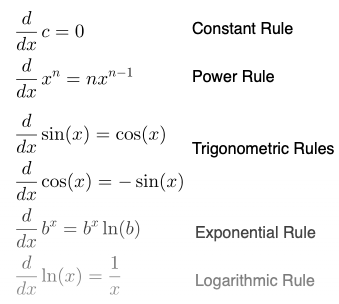Differentiation is used to caculate rate of change on a gradient of tangent to a curve with the function of change in x is a change in y that can be seen as (dy/dx). For example, the change of velocity in acceleration
 (Sacchetti S., 2024)
(Sacchetti S., 2024)
| Rules | Formula | Explain | Example 1 | Example 2 |
|---|---|---|---|---|
| Constant Rule | $$\frac{d}{dx} c = 0$$ | Any number(indicated with "c") without a x axis is equal to zero | $$10 ==> 0$$ | $$69 ==> 0$$ |
| Power Rule | $$\frac{d}{dx}xⁿ = nx^{n-1}$$ | When x axis has power, time number of power to x and remove a power from x | $$x^2 ==> 2x$$ | $$2x^4 ==> 8x^3$$ |
| Trigonometric Rules | $$\frac{d}{dx} \sin(x) = cos(x)$$ | Sin turns into cos | $$\sin(5) ==> \cos(5)$$ | $$\sin(45) ==> \cos(45)$$ |
| Trigonometric Rules | $$\frac{d}{dx} \cos(x) = -sin(x)$$ | Cos turns into -sin | $$\cos(5) ==> -\sin(5)$$ | $$\cos(45) ==> -\sin(45)$$ |
| Exponential Rules | $$\frac{d}{dx} b^x = b^x\ln(b)$$ | Exponential turns into log | $$\frac{d}{dx} b^5 = b^5\ln(b) $$ | $$\frac{d}{dx} b^45 = b^4\ln(b) $$ |
| Logarithmic Rules | $$\frac{d}{dx} \ln(x) = \frac{1}{x}$$ | Log turns into fraction x of 1 | $$\frac{d}{dx} \ln(5) = \frac{1}{5}$$ | $$\frac{d}{dx} \ln(45) = \frac{1}{45}$$ |
Example 1, differentiate and find any stationary points of y = x³ - 6x² + 9x + 1.
Using the power rule (d/dx * xⁿ = nxⁿ⁻¹ )
x³ - 6x² + 9x ===> 3x² - 12x + 9
and the constant rule(d/dx *c = 0)
1 ===> 0
now factorise to make x = 0 (there many methods to solve this, but quadratic is one of the a reliable ways. Due to the question being easy, I will not be using it)
3x² - 12x + 9
divide all by 3 to make 3x² on it own
x² - 4x + 3
-1 and -3 are the factors because when added together they make -4 and when time, they makes 3
(x - 1)(x - 3)
Slove for x by moving them to the other side
x - 1 = 0 ===> x = 1 and x - 3 = 0 ===> x = 3
∴ there is a MAXIMA at x = 1 or 3
This can be seen in a graph below:
Click for exact equation = https://www.desmos.com/calculator/m3qoxoz7dz
The blue line represent x = 1 because that was the highest point in that curve so the black line represent x = 3 due to lowest point in that curve
test
test
You don't have to stop when you have done it once, you can keep doing it mutiple times
$$ y = \sin(x): \frac{dy}{dx} = \cos(x), \frac{d^2y}{dx^2} = -\sin(x), \frac{d^3y}{dx^3} = -\cos(x), \frac{d^4y}{dx^4} = \sin$$
There is a power depending on how many times you have done it on thr top d and x
There are quiz at https://www.bbc.co.uk/bitesize/guides/zyj77ty/test
Click for referance(bitesize)